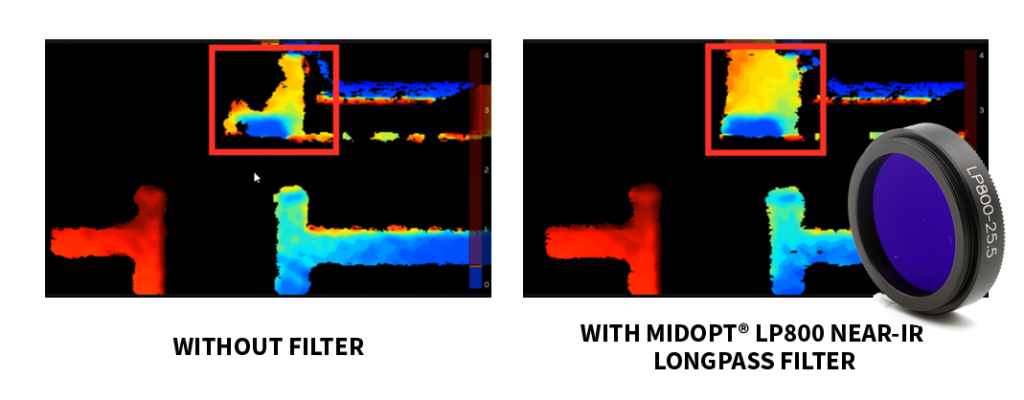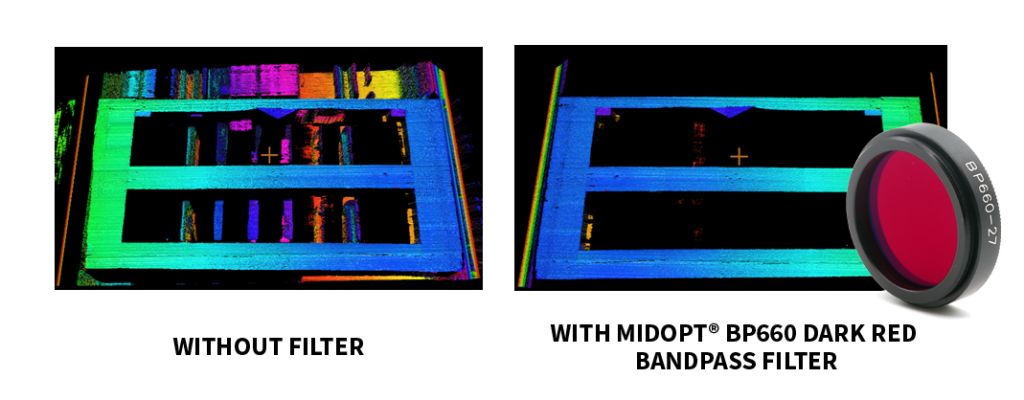
With the recent rise in use of 3D and structured lighting imaging, there are new dimensions of applications that can be solved. The principle of a 3D vision system is not that different from a standard 2D vision system. You need an illumination system, typical red or IR laser projecting a line on the part. A lens in front of the imaging sensor that is usually fixed or changeable that sets the field of view per the working distance. Sounds simple right? Well, this system is missing one important component, a Midopt Optical filter.
A machine vision filter can control interfering ambient light. In our first example (Image 1), the system projects a pattern onto the part using an internal IR 850nm laser source to produce depth data. The first image on the left is taken with a no cut Filter. Due to visible ambient light leaking into the field of view, it interferes with the image capture. When integrating a Midopt Near-IR Longpass filter onto the imager, we can filter out the ambient light. This allows the system only to see the illuminated pattern on the part creating accurate depth data.
When it comes to 3D and structured light imaging systems, they usually are not as flexible as standard 2D systems. This becomes more apparent when you begin to scan bigger parts with a larger field of view. To capture the entire part, you would increase your working distance to capture more of the part. You may have a limit on the working distance due to a height restriction. To properly capture the large field of view, you must use a wide-angle lens with a large angle of incidence. This is when things begin to get tricky optically when integrating a filter. With a traditional coated interference filter, in these more compressed configurations results in contrast loss toward the edges of the image. Because of the angle imposed by the field of view (FOV) of the wide-angle lens, the passband of the filter can shift and allow shorter wavelength ambient light into the image.
Image 2 | With the Midopt incorporating StablEdge technology, high contrast is maintained even on the edge of the image compared to a traditional interference filter. – Bild: Midwest Optical Systems Image 3 | By integrating a dark red bandpass filter, the effects of ambient light restoring contrast can be minimized. – Bild: Midwest Optical Systems
High Contrast at the Edge
The engineers at Midopt came up with a solution for this in the form of StablEdge technology. StablEdge filters take advantage of absorptive filter glass to form the leading edge of the filter passband. This assures no shifting in this region, even when the lens FOV exceeds 100°. Through incorporating StablEdge technology, we can maintain high contrast even on the edge of the image compared to a traditional interference filter (Image 2).
In our last example (Image 3), we have an application example where a Midopt filter played a critical role in the success the 3D vision system. With this 3D imaging solution, we are using a 3D Sick Ranger with a red laser for 3D triangulation of a wood pallet. To image the entire pallet, an 8mm wide angle lens was needed to capture the entire part. Initially the customer begin testing without an optical filter only to find overhead ambient light was ruining the image.
Ambient reflection off the rollers underneath the part and sides of the conveyer created far too much image noise for a reliable, repeatable imaging system. By integrating a dark red bandpass filter, we can minimize the effects of ambient light restoring contrast. Since the filter was equipped with StablEdge filter, despite the use of a wide-angle lens, we were able to maintain high contrast even on the far edges of the image.
www.midopt.com














